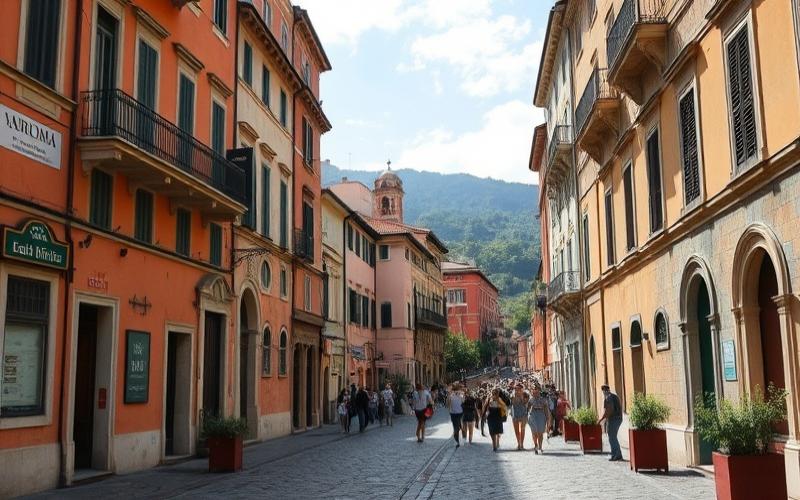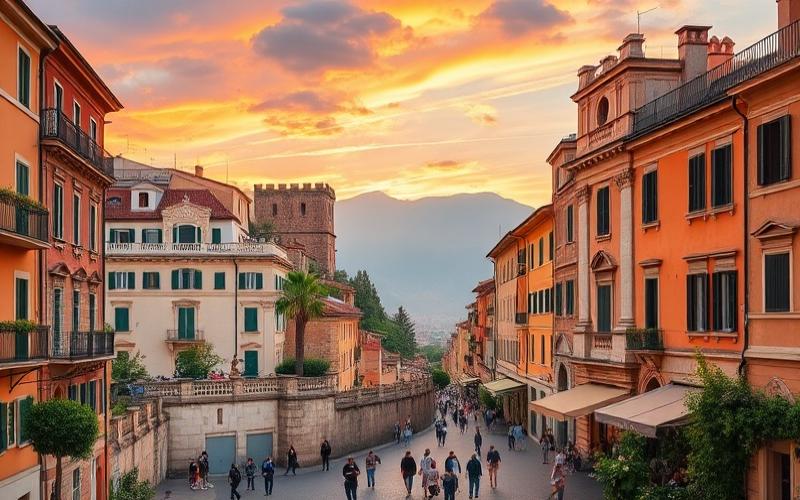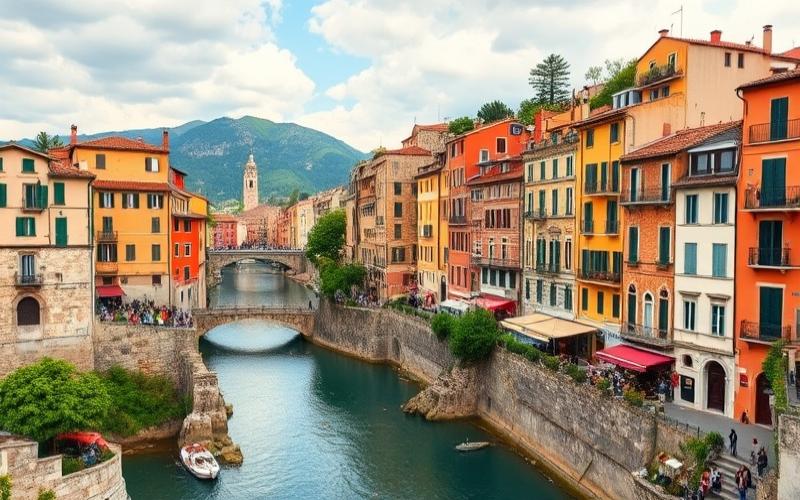
 Published on and written by Cyril Jarnias
Published on and written by Cyril Jarnias
Navigating Italy’s real estate market can prove challenging due to the numerous potential pitfalls buyers may encounter, including the use of retouched photos to enhance properties for sale.
These unethical practices, although common, can deceive even the most experienced buyers, making it essential to know how to decipher subtle clues that might reveal an enhanced photo.
Good to Know:
In this context, it’s crucial to remain vigilant about overly polished images and learn to distinguish reality from artifice in order to make an informed investment in one of Europe’s most sought-after real estate destinations.
Avoiding Scams in Italian Real Estate
“Too perfect” listing photos are often retouched: prioritize an in-person visit and systematically compare the listing to the actual property before any commitment. Wide-angle lenses, light/color adjustments, and flattering framing can radically transform the perception of space, views, and property condition.
Photo Warning Signs
- Abnormally saturated colors, rooms “bathed in light” without consistent light sources, brilliant whites without realistic shadows.
- Inconsistent perspectives: walls that “open up,” overly distorted vanishing lines, objects with strange proportions (extreme wide-angle effect).
- Overly smooth textures, missing reflections/shadows, jagged edges around objects indicating local retouching.
- Framing that systematically avoids ceilings, floors, radiators, windows, or facades, potentially hiding moisture, cracks, overlooking views, or nuisances.
- Attractive exterior views that aren’t representative (framing excluding poles, roads, noisy thoroughfares).
Common Modification Types and How to Spot Them
- Brightness/exposure and white balance: “yellowed” walls made white again, artificially bright rooms; compare light intensity to shadows and visible windows.
- Saturation/contrast: gardens “tropicalized” with greens, overly blue skies; look for natural gradients and consistency between rooms.
- Straightening/cropping: overly “perfect” lines and hidden areas; request floor plans and 360° views covering angles and ceilings.
- Wide-angle/ultra-wide-angle: rooms appearing deeper/wider than reality; spot “stretched” furniture and abnormally wide doors.
- Virtual staging or digital cleaning: removal of imperfections, addition of furniture; look for shadow inconsistencies and repeated textures.
Practical Tools for Verifying Images
- Reverse image search (Google Images, TinEye) to detect image reuse or different properties.
- Context checks: compare visible weather/season in photos with the description; analyze virtual tour continuity (proportions, materials, transitions between rooms).
- Request additional media: unedited videos, live video, dimensioned floor plans, and dated photos of “unshown” areas (stairwells, basements, facades).
Crucial Importance of Physical Visits
Portals and wide angles can create “enchanting impressions” that collapse on-site; only an in-person tour reveals noise, odors, overlooking views, the actual condition of common areas, and surroundings.
During the visit: measure rooms, test openings, water pressure, exposure at different times, check for moisture and ventilation, and observe the neighborhood (traffic, services, nuisances).
Frequent Deceptive Practices in Listings
- Surface areas: confusion between commercial area, “calpestabile” (livable) area, improper inclusion of balconies, basements, or common areas; request separate “calpestabili” and “lorde” areas and verify them on dimensioned plans.
- Property condition: terms like “ristrutturato” or “pari al nuovo” used generously; examine finishes, installations, windows, and actual compliance during the visit.
- Location and views: framing avoiding roads, power lines, or close neighbors; check from the street and via local orthophotos/maps.
Italian Public Resources for Verifying Information
- Visure catastali e ipotecarie (Agenzia delle Entrate – Catasto): to compare surfaces, categories, cadastral income, and ownership; useful for detecting discrepancies with the listing.
- Urban certificates (Comune): urban/building compliance, habitability, presence of unresolved violations.
- Planimetria catastale: to compare with the plan provided by the seller; inconsistencies = red flag.
- Estratto mappa/visure planimétricas: for plot boundaries and footprints.
- APE (Attestato di Prestazione Energetica): verifies the energy class declared in the listing.
- Conservatoria dei Registri Immobiliari: charges, mortgages, easements.
- Major Italian listing portals (idealista.it, immobiliare.it, immoscout24.it): cross-reference posting history, old photos, price variations, and inconsistencies between platforms.
Official Documents to Require for Securing a Transaction in Italy
- Seller’s identification document and tax code.
- Title of origin (deed of sale, inheritance, donation).
- Mortgage search and certificate free from mortgages/encumbrances.
- Cadastral search and plan consistent with the actual state.
- Urban/building compliance certificate and certified habitability declaration (if available).
- Valid APE.
- Installation certificates (electricity, gas) if renovated, attesting compliance.
- Condominium expenses, assembly minutes, and certificates of no arrears (for co-owned units).
- Preliminary contract (compromesso) drafted and registered with adequate suspensive clauses, followed by a notarized deed.
Best Practices to Avoid Scams
- Always condition any offer on complete document verification, on-site visit, and urban/cadastral compliance.
- Pay deposits only to verified accounts and after signing a clear compromesso; prefer notarial channels.
- Require delivery of dimensioned plans and a metric survey before any significant payment.
- Keep all communications and request written confirmations of essential characteristics (surface area, condition, charges).
Engaging Trusted Professionals
An experienced local real estate agent can filter “enhanced” listings, organize targeted visits, and verify consistency between reality, cadastral, and urban records.
A lawyer specialized in Italian real estate law secures the compromesso, suspensive clauses, and audits titles, mortgages, and compliances, reducing the risk of disputes and fraud.
Engaging an independent professional remains crucial when the local market is opaque or highly competitive, or when renovations/urban surroundings complicate due diligence.
Table: Frequent Modifications and Detection Clues
| Common Modification | Intended Effect | Detection Clues in Photos | Additional Verification |
|---|---|---|---|
| Increased brightness/exposure | Brighter and “newer” room | Inconsistent shadows, “blown out” windows | Visit at different times, raw video |
| High saturation/contrast | Flattering colors | Overly blue skies, overly vivid greens | Compare rooms, weather on the day |
| Extreme wide-angle | Amplified volumes | Distorted furniture, “opened” walls | On-site measurements, dimensioned plan |
| Cropping/masking | Defects excluded from frame | Absence of ceilings/floors, radiators | Request 360° views, targeted photos |
| Virtual staging/local retouching | Removal of defects/additions | Smooth textures, missing reflections | Unedited video, physical inspection |
Express Checklist Before Proceeding
- Perform a reverse image search on all key photos.
- Request dimensioned plan and planimetria catastale, then compare.
- Verify APE, cadastral/mortgage search, and urban compliance.
- Schedule physical visit and neighborhood tour, daytime and evening.
- Consult trusted agent or lawyer before any deposit.
Good to Know:
To avoid real estate scams in Italy, be vigilant about retouched listing photos, which can enhance lighting, hide defects, or enlarge room appearance; always prioritize an in-person visit to get an accurate idea of the property. Be wary of declared surface areas that may include non-livable spaces like balconies or basements, and verify the property’s actual condition beyond visual appearances. Consult accessible Italian cadastral records online to validate property information, and request the urban compliance certificate to avoid bad surprises. Engaging a trusted local lawyer or real estate agent will help you navigate the complex market and secure your transaction.
Verifying a Real Estate Listing in Italy
Essential steps to verify the credibility of listing photos:
- Check consistency of natural light, shadows, reflections, and perspectives; spot overly wide rooms, “overexposed” windows, or unrealistic proportions, possible signs of retouching.
- Use reverse image search tools (Google Reverse Image Search, TinEye) to check if photos have been reused from other listings or come from image banks; employ analysis tools (e.g., PhotoForensics) to detect manipulations (cloning, retouching halos).
- Verify supposed date and location: compare exterior views, street signs, window/woodwork style, landscape, and weather with Street View/Maps; request dated photos or metadata when possible.
- Compare all visuals with similar listings in the same neighborhood to spot reuse or glaring inconsistencies.
- Look for clues of intentional omission: absence of exterior views, framing avoiding ceilings/walls, distorting mirrors, overly “wide-angle” shots.
Consulting Plans and Virtual Tours:
- Request the dimensioned plan to verify surface area, layout (room orientation, circulation), presence of technical elements (ducts, load-bearing walls), and consistency with photos.
- Watch a 3D/360° virtual tour to validate space continuity, actual volumes, and lighting from different angles; compare the tour with photos and plan to detect any discrepancies.
Importance of Requesting Additional Photos/Videos:
- Request targeted series: facades (front/rear), common areas, meters, views from each window, under sinks, electrical panels, floors/baseboards, sanitary elements, storage spaces, and basements.
- Demand a short dated “walkthrough” video where the agent states the address and walks through each room without cuts, for a more authentic perspective.
- Compare these new media with initial visuals to verify consistency of furnishings, lighting, and wear.
Careful Reading of the Listing Description:
- Note inconsistencies in surface area (SLP vs. commercial), floor level vs. elevator presence, announced heating vs. visible radiators, low charges vs. listed services.
- Spot euphemistic vocabulary (“cozy,” “needs refreshing”) and omissions (absence of DPE/APE, heating installation year, cadastral status), then request documented clarifications.
Examining Reviews of the Agency or Owner:
- Consult online ratings, social media, and local forums; prioritize detailed and dated reviews, and recurrence of negative points (response times, transparency).
- Verify legal existence and professional registration when relevant; cross-reference business name, address, phone number, and consistency of public information.
Tips for Direct Contact with the Real Estate Agent (Targeted Questions Checklist):
Evidence and Documents:
- Latest property deed, cadastral plan, urban compliance, installation certificates (gas/electricity), condominium charges, and recent meeting minutes.
Property Technical Details:
- Year of construction/renovations, materials, insulation type, energy class, heating type and monthly costs, presence of moisture/noise, exposure.
Legal and Administrative Aspects:
- Rental situation (current lease), easements, mortgages, compliance of declared surfaces, possible fines or disputes.
Context and Environment:
- Nuisances (traffic, bars), nearby urban projects, distances to services, condominium rules (pets, rentals).
Visuals and Verifications:
- Request a dated uncut video, GEO/timestamped photos, access to full virtual tour, and an on-site or real-time video call to show sensitive areas.
Useful Additional Digital Checks in Italy:
- For websites or links sent by the agent (listings, auctions, payment pages), check domain ownership and registration date via WHOIS; be wary of recently created sites not linked to an identifiable entity.
- In case of “auctions” or overly attractive offers, confirm legal registration of intermediaries and avoid any deposit before complete document verification.
| Step | Objective | Tools/Evidence to Request |
|---|---|---|
| Reverse image search | Detect reuse/theft of photos | Google Reverse Image Search, TinEye, PhotoForensics |
| Visual consistency check | Spot retouching and misleading angles | Analysis of perspectives, reflections, wide-angle, exterior views |
| Plan and virtual tour | Validate surfaces, continuity, volumes | Dimensioned plan, 3D/360° tour, dated walkthrough video |
| Critical reading of listing | Identify inconsistencies and omissions | Text/photo comparison, verification of vague terms |
| Agency verification | Limit scam risk | Detailed reviews, legal existence, contact consistency |
| Link/website check | Rule out fake portals/auctions | WHOIS, domain age, clear owner identity |
Request a live video call on-site where the agent shows the meter, window views, common areas, and facade, while stating the address aloud. This significantly reduces the risk of retouched or reused photos.
Good to Know:
To verify the credibility of real estate listing photos in Italy, start by checking the date and location of these photos via metadata or by asking the agent for confirmation; use Google Reverse Image Search to identify potential retouching or misrepresentation. Consult property plans and conduct virtual tours to corroborate provided information. Request additional photos or videos for a more authentic perspective and read the description carefully to spot inconsistencies. Examine reviews about the agency or owner to assess their reliability. Finally, contact the real estate agent directly to obtain accurate property information, which will strengthen your listing verification.
Tips for a Realistic Virtual Tour
To create a virtual tour that faithfully reflects reality and avoids the pitfalls of overly retouched photos, prioritize transparent filming consistent with an in-person visit experience, using 360° tools and immersive videos compatible with mobile and desktop. Use dedicated 360° tour solutions that are easy to implement and integrable into your listings and social media to reach maximum buyers, while ensuring smooth and realistic navigation.
Lighting
- Favor natural light: film during hours of uniform daylight (morning/late afternoon) to avoid harsh contrasts and limit the need for artificial corrections.
- Turn on supplemental lighting only to compensate for dark areas, without excessive brightness or filters that alter real colors.
- Ensure exposure consistency between 360° panoramas and video shots to avoid misleading rendering between rooms.
Angles and Framing
- Position the camera at eye level (1.50–1.60 m) for a natural and stable perspective in 360° panoramas and transition shots.
- Avoid excessive ultra-wide-angles that distort volumes; prefer standard focal length for supplemental video shots, and verify that 360° hotspots respect room scale.
- Maintain simple and continuous movement paths (door to door, room to room) to reproduce realistic progression.
Honest Staging
- Highlight without concealing: declutter, clean, harmonize, but don’t remove fixed elements (radiators, meters, structural wear marks) in retouching.
- Use furniture and accessories consistent with actual room sizes; avoid unlabeled 3D renderings that could mislead.
- Display key measurements (surface area, ceiling height) on-screen or via information tags in the 360° tour to reinforce scale perception.
Modern Technologies
- 360-degree photos: capture each room with clear navigation points, add contextual information (plans, markers, captions), and ensure multi-browser and mobile compatibility.
- Immersive videos: combine 360° shots and full-screen guided sequences; ensure smooth playback on all modern browsers and easy integration into portals and social media.
- Integrations and sharing: prefer solutions that embed into real estate portals and agency websites to reduce buyer access friction.
Transparency and Trust
- Show minor defects (micro-cracks, old moisture marks, paint needing touch-up) with annotations or brief close-ups, to avoid surprises during physical visits.
- Document limitations: explicitly indicate excluded elements (specific furniture, light fixtures) and areas under renovation in tour information tags.
- Include a 2D or 3D schematic plan stabilizing understanding of volumes and traffic flow, accessible from the tour interface.
Production Best Practices
- Stabilize capture (dedicated 360° tripod/monopod) and maintain a fixed pivot point in the room center to limit parallax errors.
- Verify panorama alignment and color consistency before publication; avoid filters that excessively uniformize textures (wood, stone, tile).
- Test the tour on mobile: most buyers browse via smartphone; navigation must remain smooth and readable in touch mode.
- Add useful information directly in the tour (neighborhood, charges, renovation year) to answer recurring questions without embellishment.
Commercial Impact
Virtual tours increase engagement and meet current buyer expectations, who often want to pre-qualify a property remotely before visiting.
| Objective | Recommendation | Benefit |
|---|---|---|
| Visual realism | Natural light, neutral angles, consistent exposure | Faithful perception of volumes and colors |
| Navigation | Clear hotspots, room-to-room progression | Intuitive property understanding |
| Trust | Show minor defects and property limits | Reduced perception gaps |
| Distribution | Portal integration, mobile/desktop, social media | Increased reach and easy access |
| Conversion | Immersive videos + multi-browser 360° | Engagement and visit qualification |
Good to Know:
To create a realistic virtual tour and avoid the pitfalls of retouched photos in Italian real estate, it’s essential to focus on several key elements. Using natural lighting makes spaces bright and authentic, while choosing an appropriate camera angle avoids distortions and presents rooms faithfully. Integrating modern technologies like 360-degree photos and immersive videos offers a more comprehensive experience to potential buyers. Staging techniques should be realistic and not conceal defects, as it’s crucial to show transparency and honesty by revealing a property’s minor imperfections. This helps build trust and provide a clear picture of what visitors can actually expect.
Disclaimer: The information provided on this website is for informational purposes only and does not constitute financial, legal, or professional advice. We encourage you to consult qualified experts before making any investment, real estate, or expatriation decisions. Although we strive to maintain up-to-date and accurate information, we do not guarantee the completeness, accuracy, or timeliness of the proposed content. As investment and expatriation involve risks, we disclaim any liability for potential losses or damages arising from the use of this site. Your use of this site confirms your acceptance of these terms and your understanding of the associated risks.













































